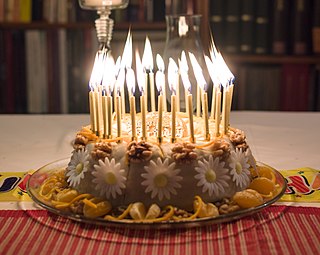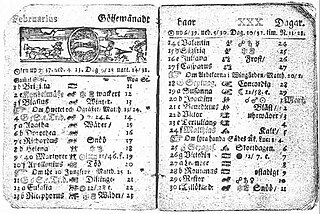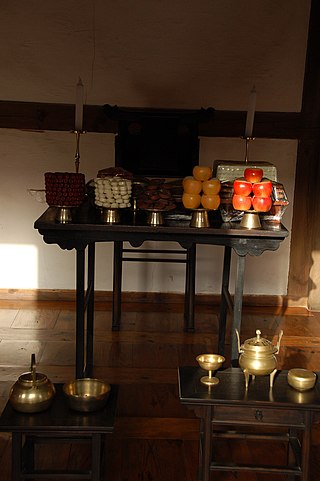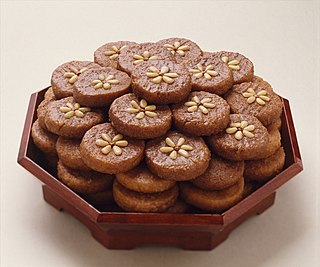
A wedding reception is a party usually held after the completion of a marriage ceremony as hospitality for those who have attended the wedding, hence the name reception: the couple receive society, in the form of family and friends, for the first time as a married couple. Hosts provide their choice of food and drink, although a wedding cake is popular.

Coming of age is a young person's transition from being a child to being an adult. The specific age at which this transition takes place varies between societies, as does the nature of the change. It can be a simple legal convention or can be part of a ritual or spiritual event.

A birthday cake is a cake eaten as part of a birthday celebration. While there is no standard for birthday cakes, they are typically highly decorated layer cakes covered in frosting, often featuring birthday wishes and the celebrant's name. In many cultures, it is also customary to serve the birthday cake with small lit candles on top, especially in the case of a child's birthday. Variations include cupcakes, cake pops, pastries, and tarts.
The sexagenary cycle, also known as the stems-and-branches or ganzhi, is a cycle of sixty terms, each corresponding to one year, thus a total of sixty years for one cycle, historically used for recording time in China and the rest of the East Asian cultural sphere and Southeast Asia. It appears as a means of recording days in the first Chinese written texts, the Shang oracle bones of the late second millennium BC. Its use to record years began around the middle of the 3rd century BC. The cycle and its variations have been an important part of the traditional calendrical systems in Chinese-influenced Asian states and territories, particularly those of Japan, Korea, and Vietnam, with the old Chinese system still in use in Taiwan, and in Mainland China. In India, the Dai-Ahom also used the sexagenary cycle known as Lak-Ni.

In Christianity, a name day is a tradition in many countries of Europe and the Americas, among other parts of Christendom. It consists of celebrating a day of the year that is associated with one's baptismal name, which is normatively that of a biblical character or other saint. Where they are popular, individuals celebrate both their name day and their birthday in a given year.

Buddha's Birthday or Buddha Day is a primarily Buddhist festival that is celebrated in most of South, Southeast and East Asia, commemorating the birth of the prince Siddhartha Gautama, who became the Gautama Buddha and founded Buddhism. According to Buddhist tradition and archaeologists, Gautama Buddha, c. 563-483 BCE, was born at Lumbini in Nepal. Buddha's mother was Queen Maya Devi, who delivered the Buddha while undertaking a journey to her native home, and his father was King Śuddhodana. The Mayadevi Temple, its gardens, and an Ashoka Pillar dating from 249 BCE mark the Buddha's birth place at Lumbini.

Traditional East Asian age reckoning covers a group of related methods for reckoning human ages practiced in the East Asian cultural sphere, where age is the number of calendar years in which a person has been alive; it starts at 1 at birth and increases at each New Year. Ages calculated this way are always 1 or 2 years greater than ages that start with 0 at birth and increase at each birthday. Historical records from China, Japan, Korea, and Vietnam have usually been based on these methods, whose specific details have varied over time and by place. South Korea officially stopped using the older system on June 28, 2023. Informal use is still widespread in the Republic and People's Republic of China, North and South Korea, Singapore, and the overseas Chinese and Korean diasporas.

Seollal is a Korean traditional festival and national holiday commemorating the first day of the lunisolar calendar. It is one of the most important traditional holidays for ethnic Koreans, being celebrated in both North Korea and South Korea as well as Korean diaspora all around the world.

Dol or doljanchi is a Korean tradition that celebrates a baby's first birthday.

A death anniversary is the anniversary of the death of a person. It is the opposite of birthday. It is a custom in several Asian cultures, including Azerbaijan, Armenia, Cambodia, China, Georgia, Hong Kong, Taiwan, India, Myanmar, Iran, Israel, Japan, Bangladesh, Korea, Nepal, Pakistan, the Philippines, Russia, Sri Lanka and Vietnam, as well as in other places with significant overseas Chinese, Japanese, Jewish, Korean, and Vietnamese populations, to observe the anniversary on which a family member or other significant individual died. There are also similar memorial services that are held at different intervals, such as every week.

Janchi-guksu (Korean: 잔치국수) or banquet noodles is a Korean noodle dish consisting of wheat flour noodles in a light broth made from anchovy and sometimes also dasima (kelp). Beef broth may be substituted for the anchovy broth. It is served with a sauce made from sesame oil, ganjang and small amounts of chili pepper powder and scallions. Thinly sliced jidan, gim (laver) and zucchini are added on top of the dish as garnishes, though various other vegetables or kimchi can also be used. The word janchi means "feast" in Korean, in reference to the festive occasions on which the dish is prepared, such as for a wedding or sixtieth birthday celebration.

Dasik is a bite-size hangwa that is normally accompanied by tea. It can be made by kneading grain or other edible seed flour or pollen with honey, then pressing them into a decorative mould called dasikpan (다식판). A dasik plate usually consists of an assortment of dasik of different colours, including green, yellow, pink, black, and white. Typical ingredients include: rice flour, pine pollen, black sesame, chestnut, and soybean.
Korean birthday celebrations or Dol are one of the important facets of Korean culture. When a person reaches an important age in his or her life, Koreans have unique celebrations to mark these milestones. Dol means it has been 365 days since the baby's birth.

A birthday is the anniversary of the birth of a person, or figuratively of an institution. Birthdays of people are celebrated in numerous cultures, often with birthday gifts, birthday cards, a birthday party, or a rite of passage.

Yakgwa, also called gwajul (과줄), is a type of yumil-gwa, which is deep-fried, wheat-based hangwa made with honey, cheongju, sesame oil, and ginger juice. Traditionally, the sweet was offered in a jesa and enjoyed on festive days such as chuseok, marriages, or hwangap (sixtieth-birthday) celebrations. In modern South Korea, it is also served as a dessert and can be bought at traditional markets or supermarkets.
Traditions of Korean family ceremonies were mainly established during the Joseon dynasty (1392–1910), which adopted Confucianism as a state philosophy. As Korean society became Confucianized, the four family ceremonies of Confucian culture have developed elaborately, and continue to influence Korean life to the present day. Ceremonial food was an important part of such cultural tradition and developed with variations across different regions and cultures.

In South Korea, etiquette, or the code of social behavior that governs human interactions, is largely derived from Korean Confucianism and focuses on the core values of this religion. In addition to general behaviour, etiquette in South Korea also determines how to behave with responsibility and social status. Although most aspects of etiquette are accepted by the country at large, customs can be localized to specific regions or influenced by other cultures, namely China, Japan, and the United States.

Korea's drinking culture interfaces deeply with its social structure, lifestyle, and traditions. The beverages themselves are also reflective of the country's varying geography, climate, and culture.

Okchun-dang or okchun, called saek-kusŭl-sathang in North Korea, is a traditional Korean sweet made of rice flour. The flat, rounded sweet is red with white, yellow and green decoration.















